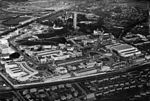Empire Exhibition, Scotland

Empire Exhibition, Scotland 1938 was an international exposition held at Bellahouston Park in Glasgow, from May to December 1938. The Exhibition offered a chance to showcase and boost the economy of Scotland, and celebrate Empire trade and developments, recovering from the depression of the 1930s. It also marked fifty years since Glasgow's first great exhibition, the International Exhibition (1888) held at Kelvingrove Park. It was the second British Empire Exhibition, the first having been held at Wembley Park, London in 1924 and 1925. Its function was similar to the first National Exhibition in Paris in 1798, and to the first International Exhibition, the Great Exhibition in London in 1851 attended by 6 million visitors.It was declared open by King George VI and Queen Mary on 3 May 1938 at the Opening Ceremony in Ibrox Stadium, attended by 146,000 people.In addition to the Royal Patrons and the Honorary Presidents representing governments and institutions here and in the Dominions, the Exhibition President was the Earl of Elgin who was also President of the Scottish Development Council, initiators of the exposition.
Excerpt from the Wikipedia article Empire Exhibition, Scotland (License: CC BY-SA 3.0, Authors, Images).Empire Exhibition, Scotland
Paisley Road West, Glasgow Bellahouston
Geographical coordinates (GPS) Address Nearby Places Show on map
Geographical coordinates (GPS)
| Latitude | Longitude |
|---|---|
| N 55.846666666667 ° | E -4.3158333333333 ° |
Address
Paisley Road West
G52 1EQ Glasgow, Bellahouston
Scotland, United Kingdom
Open on Google Maps








